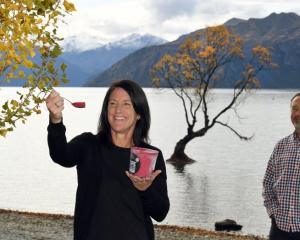
Jess Marston likes to plan, but is quickly learning that in the wine industry, you often have to go with the flow.
It started when she first discovered the possibilities of a career in the industry.
Marston was studying food technology at Washington State University on a swimming scholarship when she discovered some of the papers she wanted to do clashed with her swimming.
So she looked at the different options and discovered a paper on wine science.
‘‘It paired up well and fitted in with my swimming. I started to take classes and really fell in love with it.’’
It put a spanner in her plans - since she was 15 she wanted to get into food technology and develop new food products.
Instead, she began looking at the wine industry as a possible career, taking viticultural and wine science classes.
While she never pictured herself as a ‘‘hands-on person’’, she became really interested in the practical aspects of the science.
‘‘It’s an art form itself.’’
While the focus of the students and course seemed to be on becoming a wine-maker, Marston decided to follow the viticultural path.
Originally from Auckland, Marston returned to New Zealand with the hope of getting a job in the wine industry and managed to get her name in front of Villa Maria chief viticulturist Ollie Powrie and Marlborough viticulturist Stu Dudley.
She was offered a role as a cadet viticulturist at Villa Maria in Marlborough.
‘‘I thought it would be silly not to take the opportunity as it would give me a chance to see a bit of everything; get the big picture.’’
The job has been an eye-opener and the past 18 months have ‘‘flown by’’.
‘‘I now can’t imagine being indoors. I’m loving working outside with the vines, the nature side of it. It has opened up different doors.’’

‘‘It was a new experience, I loved it. It’s something I would not normally take part in.’’
She was surprised by how comfortable she felt in front of the camera.
‘‘The camera didn’t faze me - I like talking.’’
Discovering that executive producer and director Colin West had also gone to Washington State, but 10 years earlier, was quite cool, she said.
‘‘The crew were fun to hang out with.’’
She is a little nervous as to what the reaction to the documentary will be.
‘‘I was grateful it was a really good harvest. I’ve heard stories of harvests affected by rain and how stressful that is. So I’m happy I had a good first harvest where the fruit was clean and we could make decisions on when to pick it based off the taste of the fruit as opposed to racing to get it off to beat the weather.’’

‘‘They have no idea about the industry. I sent a picture of the harvest at night time with the tractor headlights looking like something from War of the Worlds, which isn’t quite the image they have of handpicking grapes.
‘‘The reality is, it is quite mechanised, so it’s quite cool to be able to share what goes on for those who enjoy wine.’’
For Marston, it has been a great learning opportunity and she has been making the most of being able to absorb the knowledge of Dudley and Powrie.
‘‘Everyone is so great. There are no dumb questions; they want you to learn, to do well.
‘‘They’re a great group of people,’’ Marston said.
Her job as a cadet has seen her work in all areas of the vineyard, including safety, planning, administration and in the nursery, where young vines are cultivated.
‘‘I’ve been driving tractors. I’ve grown and learnt. It’s been nice to do the practical to marry with the theory. All the pieces of the puzzle fitted together. ’’

‘‘So you see things from the start, from growing young vines and planting through to the end product and how you sell it. It’s really cool to see that. You get to understand all parts of the process.’’
Villa Maria senior Marlborough winemaker Helen Morrison says the vineyard is relatively quiet at this time of year with about 12 staff on site but it picks up come March with about 50 staff hired for the eight-week harvest period when they ‘‘go full-noise processing’’ pinot noir, savignon blanc, pinot gris or chardonnay grapes.
The winery produces about 300,000 litres of wine a week, sending it to the Auckland bottling plant via road and rail.
‘‘We go from being completely full at the end of harvest to empty and ready to go again by the time we hit March.
‘‘It’s very cyclical in nature, not very different to the different functions happening in the vineyard during the course of a year.’’
Villa Maria is premiering the movie in 12 of its markets around the world including London, New York, Australia, Amsterdam, Bulgaria, Moscow and Stockholm.
- Rebecca Fox travelled to Blenheim courtesy of Villa Maria.
TO SEE
Vintage, Saturday, Three, 10.35pm and then on ThreeNow.
NZ WINE INDUSTRY
- Total NZ wine export value for the year ended June 2019 was $1.83billion, up 6%.
- There are 38,680ha of producing vineyards in New Zealand.
- There are 716 wineries in NZ.
- 287 million litres of wine was produced in NZ in 2019.
- Sauvignon blanc, pinot noir and chardonnay are the top three grape varieties grown in NZ.
- Marlborough is the largest-growing region in NZ, followed by Hawkes Bay.
- NZ’s largest export markets for wine are the United States, the United Kingdom and Australia.











